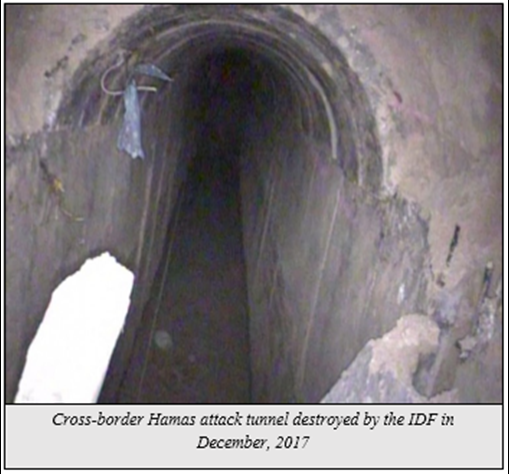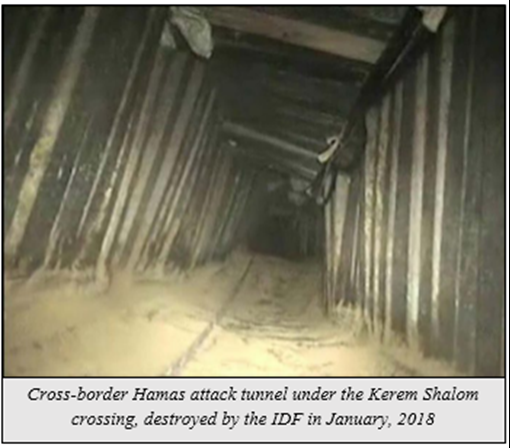The Gaza Tunnel Industry
One of the most pressing threats faced by the IDF in recent years is the network of cross-border attack tunnels from Gaza. Hamas, and other radical terror organizations in the Gaza Strip, have invested heavily in the tunnel industry, often at the cost of civilian rehabilitation. In the years since the 2014 Operation Protective Edge, Hamas’ civilian affairs budget has decreased, while its military budget has steadily grown, increasing from 15% of the annual budget in 2014 to 55% in 2016. It is estimated that Hamas has invested over $150 million in its tunnel building activities, while also endangering the many Gazans who engage in this dangerous work. The chosen locations of these tunnels further demonstrate Hamas' disregard for human life - tunnels are often built under civilian infrastructure in Gaza and end within close proximity of Israeli civilian towns, intentionally endangering both Israeli and Gazan civilians. The IDF holds Hamas responsible for these cross-border assault tunnels, which constitute a severe violation of Israel’s sovereignty and threatens the lives of Israeli civilians and soldiers.
Tunnel Collapses
In 2016, 25 tunnels collapsed in Gaza, killing 21 tunnel diggers from Hamas, Palestinian Islamic Jihad and other radical organizations. In 2017, nine tunnels collapsed and tens of tunnels were destroyed by the Egyptian army as part of their crackdown on terrorist activity in the Sinai. These incidents resulted in the deaths of 33 members of Hamas and other Islamist organizations in the Gaza Strip.
Tunnels under UNRWA Facilities
On numerous occasions, Hamas has exploited UNRWA facilities for its military operations. This phenomenon was first publicized during the 2014 Operation Protective Edge, when arms caches were discovered in UNRWA schools three times. Although UNRWA condemned this use of civilian buildings for military activity, Hamas has continued to employ this strategy in the years since the operation has ended.
On June 1, 2017, UNRWA announced that it had uncovered a Hamas attack tunnel under two of its schools, the Maghazi Preparatory Boys School and the Maghazi Elementary Boys A&B School.


![]()
![]()
Again, on October 15, 2017, UNRWA discovered yet another tunnel under one of its middle schools in Beit Hanoun. This incident was condemned for endangering UNRWA workers and the students and for violating the neutrality of this civilian site.


Cross-Border Tunnels Destroyed by the IDF
On October 10, 2017, the IDF destroyed a Palestinian Islamic Jihad (PIJ) cross-border assault tunnel that extended into Israel from the Gaza Strip. The tunnel was discovered less than two miles from the Israeli village of Kissufim. 12 PIJ fighters were killed in the explosion, five of them remaining trapped on the Israeli side of the border.

One month later, on December 9, 2017, the IDF destroyed a Hamas cross-border tunnel that extended into Israel from the Gaza Strip. The tunnel began in Khan Younis and extended hundreds of meters into Israeli territory. The tunnel was destroyed using an innovative new technology, rather than with explosives, a method that avoided the deaths caused by the previous tunnel.

On January 13, 2018, the IDF destroyed another Hamas cross-border tunnel. This tunnel, which crossed 180 meters into Israeli territory, was known to be a smuggling route for weapons and fighters in order to carry out terror attacks. Furthermore, the tunnel was located under the Kerem Shalom Crossing, a cargo crossing through which hundreds of trucks of commercial goods and humanitarian aid enter the Gaza Strip daily. The tunnel passed under three civilian sites, including a gas pipe, a fuel pipe and the main antenna of the crossing. Such strategic placement demonstrates Hamas' use of civilian infrastructure as a cover for its military activities and in doing so, endangers civilians. This tunnel further harmed the interests of the residents of Gaza who could not receive necessary goods through the crossing, which was closed temporarily due to the danger caused by the tunnel and its destruction.


